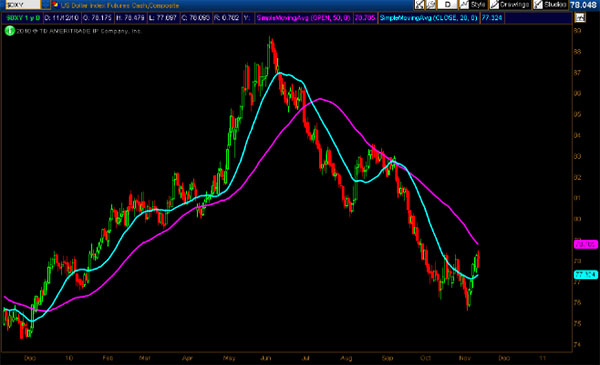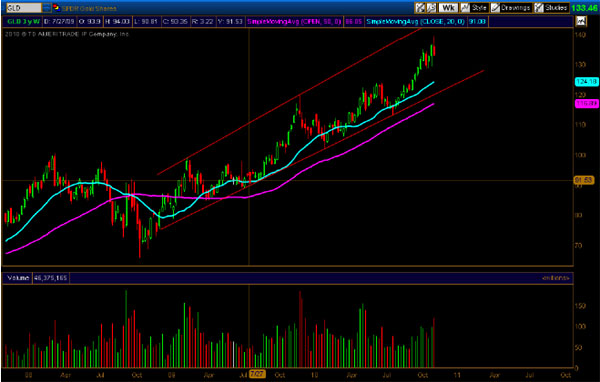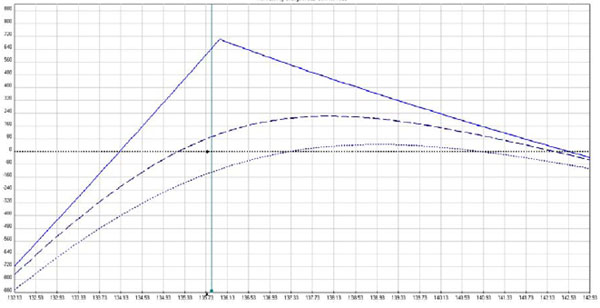
My most recent article discussed using a short-term calendar spread to capture time premium of the gold ETF GLD's weekly options. While I do not recommend that traders place trades based on my articles, I would like to point out that the most recent GLD calendar trade I posited would have produced a significant double-digit gain as of the opening bell Friday. I do not mention this to boast, but simply to point out the power of calendar spreads using weekly options and their rapid time (Theta) decay.
The horizontal volatility skew of the weekly options places the short-term calendar strategy at the top of my list based on current market conditions. By this, I mean that the implied volatility of the weekly options since their recent introduction has tended to be greater than that of the corresponding longer dated options. However, calendar spreads can be utilized in longer-term trades as well as a cheaper surrogate for equity ownership.
Currently, gold appears to be going through a pullback and possibly a major correction based on price action in the dollar and it could setup for a possible longer-term entry in time. The weekly gold chart is shown below.

Traders that believe inflation will continue to rise dramatically over the next few years might consider the following long-term calendar spread versus outright equity ownership. The strategy is precisely the same as its proverbial cousin the short-term calendar spread, however the characteristics and risk profile is somewhat different due to volatility differences on longer-dated option chains.
The strategy involves buying GLD leap (option that does not expire for one to two years or more) call contracts and regularly selling weekly call contracts against them. The process continues every week while the premium collected helps reduce the overall cost of longer dated GLD calls. The construction is fairly basic, however relatively deep in the money calls should be used for the long leap side of the construction. The weekly options to be sold against the long position will typically be at-the-money or even slightly out-of-the-money and the position will be classified as a diagonal calendar spread.
Because the longer dated calls are deep in the money and have a significant amount of time before they expire, they are somewhat insulated against volatility and have a relatively low time-decay risk. The sheer nature of option pricing enables the longer dated calls to withstand harsh volatility changes while providing the trader the ability to have similar price action as he/she would by owning GLD common stock outright. The primary advantage of utilizing options versus stock ownership is the reduced price of the option contract versus stock ownership.
As of the writing of this article, GLD in Friday's pre-market action was trading around $136/share. An option trader could purchase a January 2012 125 Call contract based on Thursday's close for $2,165 not including commissions. Purchasing 100 shares of GLD would cost an equity trader $13,600 or $6,800 if they were using a Reg T margin account. In either case, the long dated GLD leaps provide similar price action with reduced capital. For the price of 100 shares of GLD a trader could purchase 6 GLD January 2012 125 calls for 6x the exposure. However, as most astute traders will point out it is theoretically possible to lose the entire amount invested in the option contracts should gold have a major pullback in short order.
While this accusation is, indeed, correct, through the use of contingent stops based on GLD's price, this risk is mitigated to an equal amount of risk as an equity trader utilizing stops on GLD's price. In the end, the risk is inherently the same setting aside time decay suffered by the long option, which early on in this trade will be next to nothing. Additionally, the trader will be selling weekly calls against the long-dated GLD leaps to reduce the overall cost of the position allowing a trader the possibility of reaping additional upside.
The trade construction is as follows:
- Buy 5 GLD Jan 2012 Leap Calls at the 120 strike for around $23.
- Sell 5 GLD November 2010 136 calls at the 135 strike for around $2.05.

It is important to recognize that the illustrated graph represents the first of 62 anticipated sales of weekly calls against these long options that will be available prior to the LEAP's expiration.
The risk for this trade is twofold; the first risk occurs if price moves beyond the bounds of profitability. The second risk, volatility risk is not as obvious. One of the functional characteristics of LEAPS is that they are exquisitely sensitive to changes in volatility. It is for this reason we have chosen a deep in-the-money call to buy; remember that volatility changes only impact the time (extrinsic ) component of option premium and the deep in-the-money options have the least time premium embedded within their price.
Trade management includes exiting the trade if specific stop targets are hit, specific profit/loss targets on this trade are met or violation of technical support or resistance. In order to understand this trade, the aspiring option trader needs to follow both price and volatility impacts that are respective of this trade's construction. I suggest the trader journal not only the relevant prices of the underlying and its corresponding options, but also the implied volatility of each.
As with everything in life, there are no guarantees. However, this trade harnesses the power of theta decay and capitalizes on one of the basic truths of life: Tomorrow there is one less day for all of us—the same can be said for option contracts.
If you would like to receive my free options strategy guide and trade ideas, join this free newsletter: http://www.OptionsTradingSignals.com/profitable-options-solutions.php.


















































